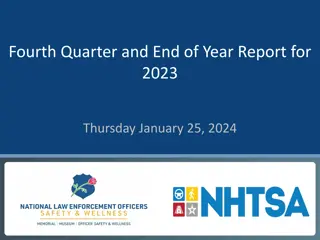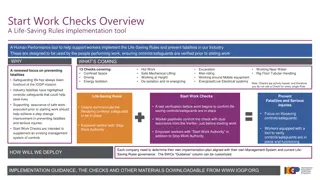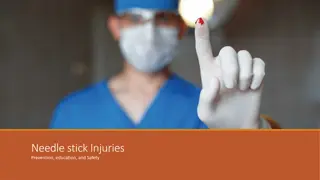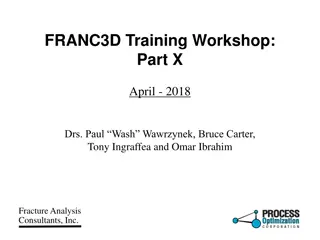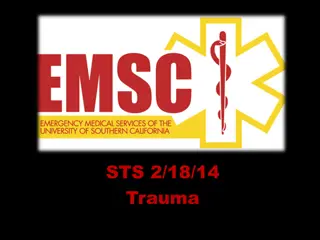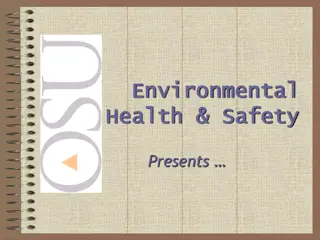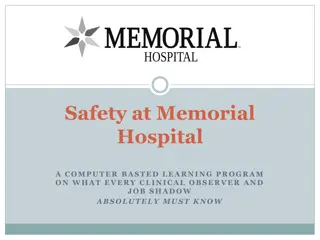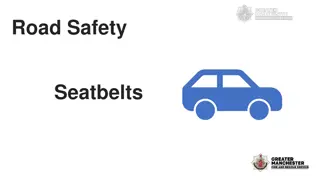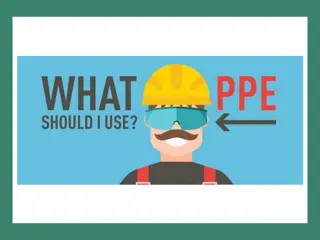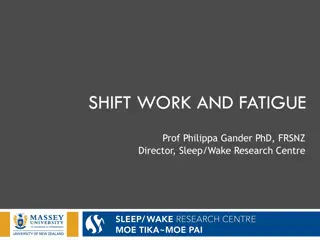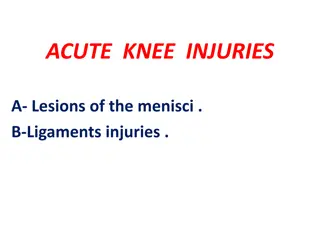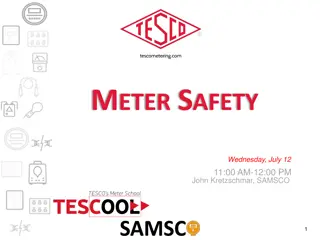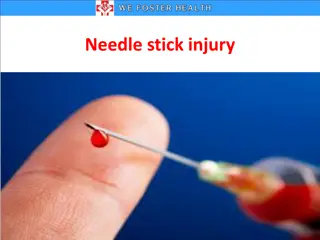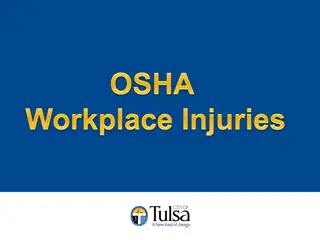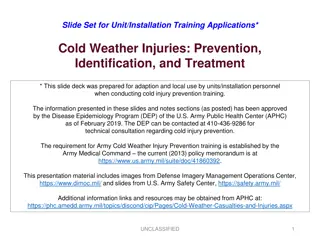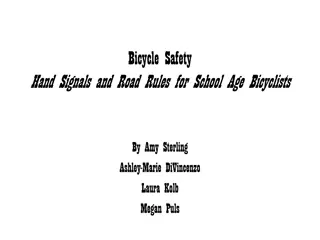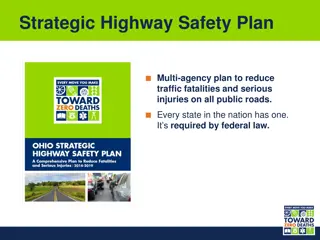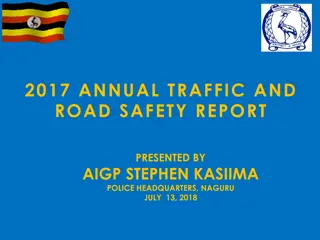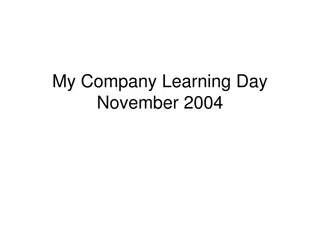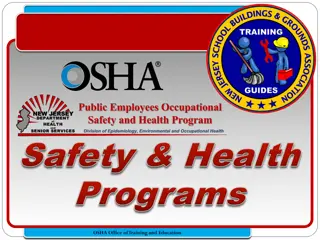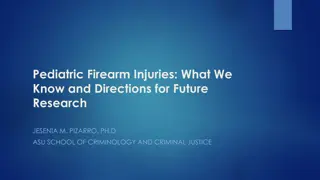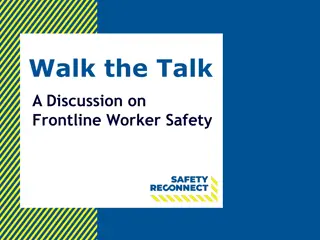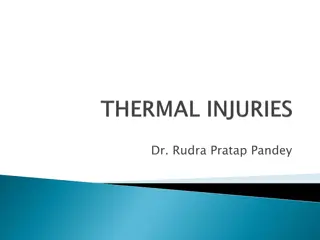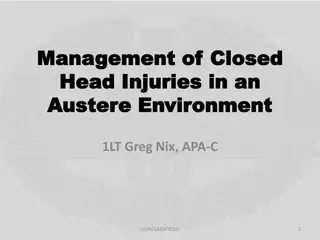Preventing Serious Injuries and Fatalities (SIF): A Paradigm Shift in Workplace Safety
The SIF approach emphasizes managing risks over injury rates to prevent serious workplace incidents. Traditional safety metrics focusing on minor injuries may not effectively prevent SIF events. Special attention and a new safety paradigm are needed to address high-risk workplaces and protect workers from potential fatalities.
Download Presentation

Please find below an Image/Link to download the presentation.
The content on the website is provided AS IS for your information and personal use only. It may not be sold, licensed, or shared on other websites without obtaining consent from the author. Download presentation by click this link. If you encounter any issues during the download, it is possible that the publisher has removed the file from their server.
E N D
Presentation Transcript
PREVENTING Serious Injuries and Fatalities (SIF) Managing RISKS rather than Injury Rates
Where did SIF come from? On January 4th, 2012, the American Society of Safety Engineers (ASSE) President Terrie Norris, issued a call to action A statistical plateau of worker fatalities is not an achievement But evidence that this nation s effort to protect workers is stalled. These statistics call for nothing less than a new paradigm in the way this nation protects workers. OSHA s Process Safety Management Standard
Why is the SIF approach necessary in HIGH-RISK workplaces? Despite extensive prevention efforts, many industries still have a high serious injury and fatality rates even though they have very low TRIR The reduction in minor/moderate/serious severity incidents rates is an important target but is NOT a sufficient indicator of the potential for serious injuries and fatalities (SIF) Safety Management Systems provide a safety net for people against risks, but special focus needs to always be given for situations that present the potential for SIF events
Reducing Minor Injuries is NOT Predictive of Reducing SIFs The Mercer/BST study group found that pillars of the safety profession may form barriers to SIF prevention H.W. Heinrich s 80-year-old safety pyramid is NOT predictive Not all injuries have SIF potential Reducing injuries at the bottom of the triangle (minor injuries) does not assure a reduction of SIFs at the top of the triangle
Reducing Minor Injuries is NOT Predictive of Reducing SIFs A 2007 Rand study stated that there is no relationship between OSHA injury rates and Fatalities The absence of minor injuries is NOT predictive of an absence of SIFs The presence of minor injuries is NOT an indicator of potential fatalities About 20% of recordable injuries have the potential to be SIFs
Reducing Minor Injuries is NOT Predictive of Reducing SIFs Injury data can NOT be the sole or primary metric for driving and assessing safety performance The long-standing assumption that most injuries result from unsafe acts, fueled and reinforced by flawed incident investigations, is INCORRECT and UNSUPPORTED These beliefs are proving to be downright harmful The problem is this: traditional safety efforts often fail to address SIFs because they re not designed to! These design lapses are due in part to current measurement systems that create a blind spot for SIF prevention
Reducing Minor Injuries is NOT Predictive of Reducing SIFs In many of the catastrophic events in recent years Columbia, Challenger, BP Texas City, Upper Big Branch Mine, Deepwater Horizon indicators of impending disaster were available but obscured by years of data showing the rate of recordable injuries was low, very low or improving Systematic assessment of SIF potential enables SIF measurement and prevention SIF prevention strategies must address less serious injuries with HIGH POTENTIAL for serious consequences and specific causes and correlates of SIF events
Reducing Minor Injuries is NOT Predictive of Reducing SIFs Several The Traditional Safety Pyramid is NOT predictive A reduction of injuries @ the bottom of the Triangle does NOT assure a reduction of SIFs Fatalities Fatality Life-Altering Injuries Moderate NOT ALL injuries have SIF potential Injuries Minor Injuries No Injuries 21% Potentially SIF with HIGH PSIF Minor Incident
The Critical Importance of Precursors The key is to IDENTIFY, ANALYZE, and MITIGATE SIF precursors Precursor data are a vitally important tool to assess risks and give signals of impending problems Use of precursor information eliminates leadership s blind spot, gives visibility to previously hidden information Precursors represent a leading indicator (not a reactionary measure) that reduces the potential to miss unmitigated exposures with high potential for SIFs A SIF PRECURSOR generally has three (3) key aspects: it is a high-risk situation where management controls are absent, ineffective, or not complied with, and will result in a serious injury or fatality if allowed to continue
The Critical Importance of Precursors Addressing SIF precursors calls for flawless execution of pre-job planning and risk assessment, job safety analysis, behavior observations, assessments and audits, and risk tolerance
The Critical Importance of Precursors Enhancements are needed for incident investigation and root cause analysis processes Remember, what categorizes a precursor is NOT its immediate outcome, but its POTENTIAL to produce a serious outcome Two employees each suffer a minor cut. The actual outcomes are identical. But one cut occurred as a worker hustled across a busy office and sideswiped a sharp-edged desk. The other cut occurred when the worker slipped and nearly fell from the top of a rail car. To identify which of these two events is a precursor, ask yourself what would happen if the situations were repeated. The office worker would likely see a similar or better outcome. But the potential exists for the rail worker to suffer a fall from a height, resulting in a fatality or serious injury.
Assess Systems Integrity and Conformance Safety Management Systems should be examined to determine their effectiveness at identifying and mitigating precursors A pipe leaks, it contains flammable material, no one reports the leak, no inspection identifies it, the leaking material finds an ignition source, and there is a fire The chance that this was the first and only time any of these events has occurred is low; it is much more likely that leaks have occurred previously, the reporting of leaks is sporadic, and inspections are not comprehensive Both the DESIGN of the safety management systems targeting SIFs (their integrity), and the QUALITY of how they are implemented (conformance) need to be assessed
Four (4) steps to PREVENT SIFs 1. Educate the organization on the prevention of SIFs a. Everyone at all levels of the organization must be aware and alert to the fact that just managing injury rates is not enough b. The company is still vulnerable to SIF exposures
Four (4) steps to PREVENT SIFs 2. MEASURE SIFs and PSIFs as a KPI (rate) The SIF rate is the number of serious and fatal injuries and recordable injuries with reasonable potential to be an SIF divided by hours worked a. Data on the SIF rate should be gathered for the past 2-3 years and from this point forward b. The SIF rate must have high visibility throughout the organization
Four (4) steps to PREVENT SIFs 3. DEVELOP and IMPLEMENT Safety Management System (SMS) elements to: 1. IDENTIFY Hazards and SIF Precursors 2. ANALYZE the Hazards and SIF Precursors 3. ASSESS the level of RISK they pose 4. MITIGATE RISK from Hazards and SIF Precursors This is the basis of the SIF PREVENTION strategy
Four (4) steps to PREVENT SIFs 3. Embed findings from SIF assessments into existing safety management systems, including a. pre-task risk assessment, b. observation and feedback, and c. incident investigations so these systems now address SIF Precursors Enhance your incident investigation and root cause analysis protocols Go beyond obvious errors to find LATENTCONDITIONS that may represent SIF precursors




